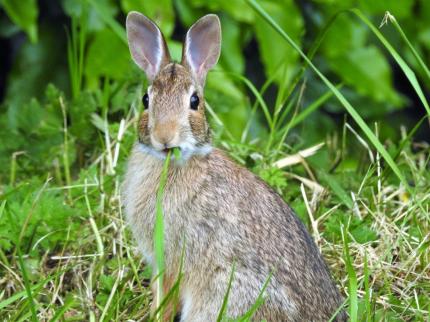
Rabbits can be found throughout the state -- from the backyards of suburban neighborhoods to the shrub steppe of eastern Washington. Two species of rabbits are native to Washington and two others have been introduced to the area. Washington is also home to three species of hares: the snowshoe hare and two others, called “jackrabbits.”
Rabbits differ from hares in that female rabbits give birth to blind, hairless young that require considerable attention for their first two weeks of life. Hares are born fully furred with their eyes open, and can hop about within hours of their birth. Rabbits and hares are most active at dawn and dusk. Because their eyes shine yellow or red in a flashlight beam, they are easily seen at night.
Facts about Washington rabbits
Food and Feeding Habits
- From spring to fall, rabbits and hares eat grass, clover, wild flowers, weeds, and farm and garden crops. In winter, their diet shifts to buds, twigs, bark, conifer needles, and practically any green plant.
- In dry interior areas, Nuttall's cottontails climb sloping tree trunks to access green, dew-laden vegetation.
- Rabbits and hares re-ingest their droppings to further digest the material, a process called coprophagy. After returning to their shelters, they pass soft pellets containing undigested vegetation, and then eat these at a more leisurely pace, later passing hard pellets.
Nest Sites and Shelter
- Females of most rabbit species create a shallow, bowl like nest called a “form,” and line it with leaves, grass, and fur plucked from their bellies.
- Female domestic rabbits (and our rare Pygmy rabbits) excavate burrows for their shelter and den site.
- Where soil conditions and food supplies permit, domestic rabbits live in groups in large, complex burrow systems called “warrens” (Fig. 2).
- Nests and dens are located in or near brushy fencerows or field edges, brush piles, gullies containing shrubs, and landscaped areas with suitable cover.
Reproduction
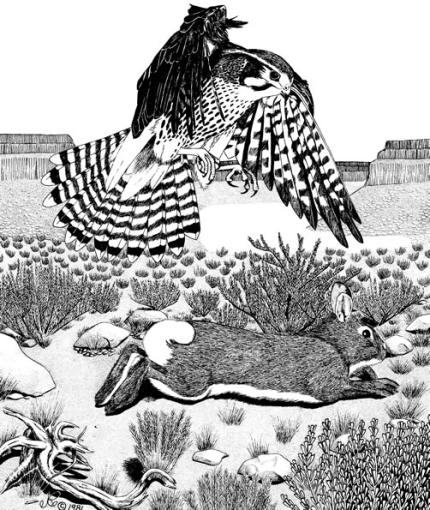
- The breeding season for rabbits begins in mid February and can continue through late summer. Famous for their reproductive abilities, rabbits have a 30-day gestation (pregnancy) period, and have several litters containing four to eight young each year.
- For about two weeks, the mother rabbit stays away from the nest so as not to show predators the location of the young, returning only at dusk and dawn to nurse and lick her young clean.
- At two weeks of age the young rabbits begin to eat vegetation; at four to five weeks old they are feeding alongside their mother.
- The number of rabbits in a given area will increase and decrease in a cycle connected with predator populations and food availability.
Mortality and Longevity
- Adult rabbits are preyed on by large hawks and owls, domestic dogs, coyotes, foxes, and bobcats. Vehicles also kill many rabbits (Fig. 2).
- The young are eaten by mink, skunks, long-tailed weasels, gopher snakes, and domestic cats; young in nests are vulnerable to weed-wackers, lawn mowers, hay mowers, and other agricultural equipment.
- Rabbits may live two or more years in the wild, but when predators are numerous and weather conditions are extreme, they seldom live more than a year.
Common rabbits of Washington
Native Rabbits
The Nuttall's cottontail (rabbit) (Sylvilagus nuttallii), averages 14 inches in length, is gray or brownish-gray, and has a relatively short, inconspicuous white tail. It is found in sagebrush areas, weed and tall-grass patches, and orchards throughout eastern Washington.
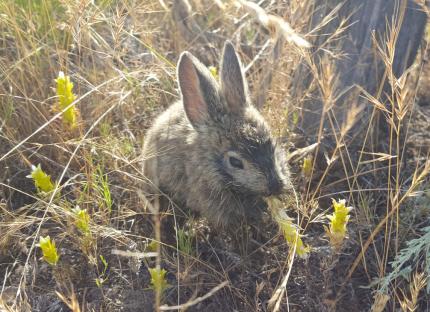
The Pygmy rabbit (Sylvilagus idahoensis)(Fig. 3) is the smallest rabbit in North America, measuring only 11 inches in length. It is slate-gray with a buff-colored tail and is found in the dense sagebrush and rabbitbrush areas of south-central Washington (where fewer than 50 of these rabbits exist)
Introduced Rabbits
The Eastern cottontail (rabbit) (Sylvilagus floridanus)(Fig. 1) was introduced to several areas in Washington as a game animal beginning in the 1930s. It averages 17 inches in length and is light brown in color; the white underside of its 2-inch tail is readily visible when the rabbit runs. It is commonly seen along roads, brushy fencerows, and blackberry thickets in and around areas where it has been introduced.
The Domestic (European) rabbit (Oryctolagus cuniculus) is another introduced species. Also known as the European rabbit or Belgian hare, this single species is the ancestor of all domestic rabbits (about 80 varieties!). The domestic rabbit is considerably larger than other Washington rabbits, measuring 20 to 30 inches in length. It has black, white, brown, or multicolored fur, and is most frequently seen in the San Juan Islands where it was first introduced in 1900, although it is spreading into other areas where it has been released.
Viewing rabbits
During the day, rabbits rest under overhanging limbs, brambles, brush piles, old farm implements, and junk. In extreme cold or heat, they may seek greater protection by burrowing into snowdrifts or using another mammal's unoccupied burrow (Fig. 4).
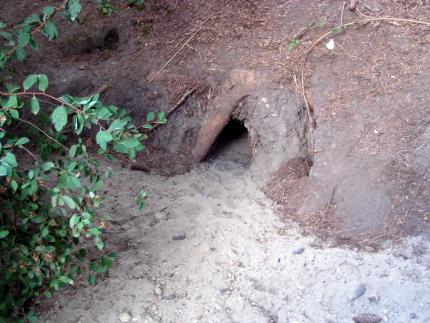
Rabbits' survival depends on their sitting still for long periods, a trait they've likely developed to avoid being seen by predators who watch for movement. Indeed, the most common way to find a rabbit's or hare's resting site is by accidentally scaring the animal from it.
Rabbits establish safe "bolt areas," then move out in a radius from those safety points to forage, always keeping bolt areas nearby. Animals on the move are highly stressed because they are insecure until they know the safe places they can bolt to.
Trails
Rabbits commonly feed and travel along human paths, rural roads, and roadsides.
Heavily used rabbit trails look like 4-to 5-inch wide paths in grass, dirt, decaying vegetation, and snow. In tall grass, trails are more tunnellike. Tall blackberry thickets are a favorite shelter, and nicely pruned little tunnels can be seen leading into these thickets
Tracks
Rabbit tracks show four toes on each print, with the hind tracks being about two and a half times as long as the front. The claws occasionally register, and on hard ground this may be the only sign of a passing rabbit or hare.
Droppings
Rabbit droppings are easy to identify in any season and are found in groups of five to ten scattered on the ground in feeding areas (Fig. 4). Droppings are generally spherical, sometimes slightly oblong or irregular, but never acorn- or capsule-shaped like those of deer and elk. Rabbit droppings are about 3/8 inch in diameter, and are composed of light brown, sawdust-like material.
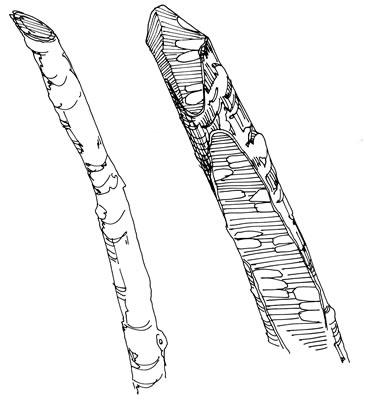
Feeding Areas
Look for the clean-cut, angled clipping-off of flower heads, buds, and young stems up to ¼ inch in diameter (Fig. 5). Evidence of gnawing can be found on the stems of woody plants, blackberry canes and other brambles, and on fallen twigs and branches.
A rabbit's feeding area can also be located by looking for grass, clover, plantain, and other weeds kept cropped to within an inch or two of the ground.
In areas covered with snow, young plants may be clipped off at snow height, and the smooth, thin bark of trees and shrubs may be completely girdled.
Twig clipping by rabbits and hares is sometimes confused with deer browsing. Deer damage can be identified easily: It occurs above 2 feet and, because deer have no upper front teeth and must twist and pull when browsing, they leave a ragged break. Rabbits clip twigs off cleanly, as if with a knife.
Dust Baths
Rabbits and hares roll in dust baths to help rid themselves of external parasites. These are small areas of sand or dry soil, about a foot (30 cm) in diameter, that have been cleared of vegetation, possibly through the animals' scratching or through repeated use.
Calls
The large feet of the snowshoe hare make a good sound thump, and often when a family group is together, one will be lookout and thump a warning when something suspicious approaches. A rabbit or hare captured by a predator emits a loud, high-pitched scream.
Preventing conflicts
A rabbit's appetite can get it into trouble with gardeners, landscapers, orchardists, and foresters throughout the year. The following are suggestions for preventing conflicts. For best results, use control methods at the first sign of damage. Once rabbits and hares are used to feeding in an area, all control tactics become less effective.
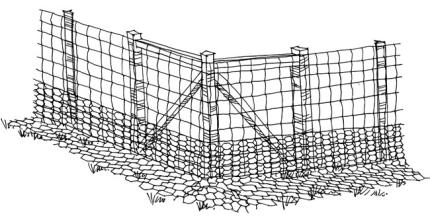
Fences:
Fences provide the most long-term and effective way to protect plantings from rabbit damage. For rabbits, a 2-foot tall fence, constructed with 1-inch mesh chicken wire and supported by sturdy stakes or posts every 4 to 6 feet will exclude the animals from an enclosed area. Larger hares (jackrabbits) ordinarily will not jump a 2-foot fence unless chased by dogs or otherwise frightened. Increasing the above-ground height to 3 feet will prevent them from jumping a fence. Where deep snow is common, fences will need to be higher, or adjusted to exclude animals during winter.
Rabbits and hares are more likely to go under a fence than over it. To prevent this, place the bottom of the fence 6 inches underground, stake the bottom of the fence flush to the ground, or line the bottom of the fence with rock, bricks, fence posts, or similar items. Anther option is to create a 1-foot wide wire apron on top of the ground on the animal side of the fence. Be sure to secure the apron firmly with stakes (Fig. 6).
Electric netting (a type of electric fence) is also suitable for rabbit exclusion. It is designed for ease of installation and frequent repositioning. Electric netting is intended for temporary use at any one site, making it ideal for seasonal gardens. Daily inspections will be necessary during the first three weeks after installation. If maintenance is poor, rabbits can do considerable damage to electric netting fences by chewing through the wires. This could result in sections becoming inoperative, which may be difficult to detect. Note: Before purchasing the product, ask the representative about the effects of electric netting on frogs, toads, and baby rabbits.
The lower 2 to 3 feet of an existing fence or gate can be covered with 1-inch wire mesh to exclude rabbits. Attach the protective wire to the fence at enough points to prevent sagging, and follow the above recommendations to prevent rabbits and hares from pushing through from underneath. Use tight-fitting gates and keep them closed as much as possible.
Inspect the fence regularly to make sure animals have not dug or pushed their way under it, or worked their way over it. Once a rabbit gets into a fenced area, it may not be able to get out without being directed to a gate or other opening.
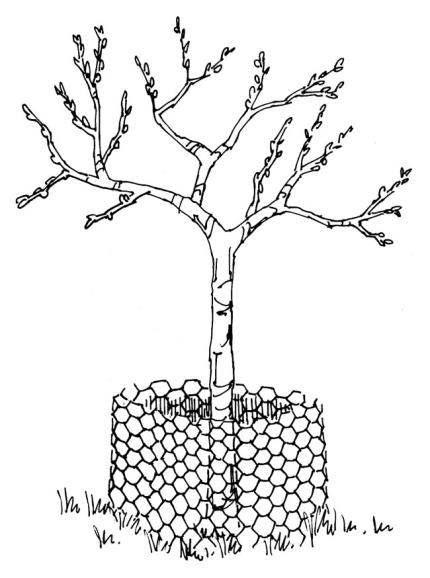
Other barriers
In some cases, protecting individual plants may be more practical than excluding from an entire area. Newly planted vegetables can be protected using commercially sold cloches or 1-gallon plastic milk containers that have the bottom cut out. Placed over the seedlings, they provide protection from animals as well as late frosts.
One-inch mesh chicken wire can be cut and formed into cylinders and placed around plants needing protection (Fig. 7). Bury the bottom of the cylinders 3 inches below the soil line and brace them away from the plants so animals cannot press against the cylinder and nibble through the mesh. Inspect these barriers regularly to keep the area inside the barriers clean of leaves, weeds, and other debris, which can hide damage caused by mice and voles.
Individual plants can also be protected with a variety of commercially available protectors, including nylon mesh and plastic tubes; aluminum foil has been double-wrapped around small trees with effective results.
Scare devices and repellents
If fencing and other barriers are impractical or undesirable, or if damage is so slight that fencing is not cost-effective, scare devices can provide temporary control. Visual scare tactics include mylar tape and mylar party balloons located above areas of potential damage, and pinwheels and other devices located at ground level. However, urban and suburban rabbits are often unafraid of such devices and other rabbits quickly get used to them. Ultrasonic units, which rely on sound waves to repel rabbits, have not been proven effective. A dog can help keep rabbits away, especially if it is outside and awake at night.
Plants may also be protected with commercially available or homemade taste repellents that render the treated plant inedible. Research has shown that repellents with putrescent whole-egg solids can reduce browsing by rabbits.
Apply repellents before damage occurs and reapply frequently, especially after a rain, heavy dew, sprinkler irrigation, or when new growth occurs. In all cases, follow the label directions for the repellent you are using. Many repellents cannot be used on plants or plant parts to be eaten by humans.
Other nonlethal control methods
Encouraging natural predators of rabbits and hares—or at least not interfering with them—may aid in reducing plant damage. It is common to provide perches for owls and hawks in some commercial areas to control rabbits, hares, and small rodents.
Another form of control is to remove brush piles, weed patches, rock piles, and other debris where rabbits live and hide. Before doing this, consider the potential impact on other desirable wildlife species.
Plant rabbit-resistant plants
Protecting vulnerable plants from rabbit damage within a fence, and landscaping with rabbit resistant plants elsewhere makes an effective combination. A walk or drive through the neighborhood can give you an idea of what plants are less palatable to these animals. Note: When preferred foods become scarce, there are few species that rabbits will not eat.
Live Trapping Rabbits
Trapping and moving wild rabbits several miles away has appeal as a method of resolving conflicts because it is perceived as giving the "problem animal" a second chance in a new home.
Unfortunately, the reality of the situation is quite different. The animals typically become disoriented, which results in them getting hit by a car or eaten by a predator. If they remain in the new area, they may cause similar problems there, or transmit diseases to other animals in the area. If a place "in the wild" is perfect for rabbits, they are probably already there. It isn't fair to the animals already living there to release another competitor into their home range to the detriment of both of them.
In many cases, moving rabbits will not solve the original problem because others will replace them and cause similar conflicts. Hence, it is often more effective to use the above recommendations for making the site less attractive to rabbits, than to constantly trap them.
Trapping also may not be legal in some cities; check with local authorities. Transporting animals without the proper permit is also unlawful in most cases.
If you cannot resolve a conflict by other means—such as removing the attractant, installing a barrier, applying a scare tactic—a final alternative is to trap the rabbit. Trapping is the last option because it presents many problems for both the animals and the trapper. Single- or double-door type wire live traps that are 9 inches high, 9 inches wide, and 26 inches long are effective at catching rabbits. To capture hares (jackrabbits) in open terrain, use a double-door trap with weighted doors to prevent escape. It is best to use a larger trap than used on rabbits.
For bait, use fresh vegetables in summer; apples, carrots, or bread in winter. Place the trap near cover where rabbits feed or rest, or where they gain entry under a fence. Place some bait just outside the trap and spray the inside with apple juice to increase effectiveness.
For detailed additional information on trapping rabbits, see Trapping Wildlife.
Lethal Control
Lethal control may become necessary when all efforts to dissuade problem rabbits fail. Shooting has traditionally been the primary form of controlling rabbits and is effective in eliminating small, isolated groups of animals. For safety considerations, shooting is generally limited to rural situations and is considered too hazardous in more populated areas, even if legal.
Public Health Concern
Rabbits, hares, voles, muskrats, nutrias, and beavers are some of the species that can be infected with the bacterial disease tularemia (see "Public Health Concerns" in Beavers). Tularemia can be acquired through ingesting undercooked rabbit meat or handling a dead or sick animal. Anyone handling a rabbit or hare should wear rubber gloves and wash his or her hands well when finished.
Legal Status
Because legal status, trapping restrictions, and other information about rabbits change, contact your local wildlife office for updates.
The Nuttall's cottontail rabbit, Eastern cottontail rabbit, and snowshoe hare are classified as game animals. A hunting license and open season are required to hunt them.
A property owner or the owner's immediate family, employee, or tenant may kill or trap the above species on that property if they are damaging crops or domestic animals (RCW 77.36.030). In such cases, no permit is necessary for the use of live (cage) traps. However, a special trapping permit is required from the Department of Fish and Wildlife for the use of all other types of traps.
Additional Information
Books
Hygnstrom, Scott E., et al. Prevention and Control of Wildlife Damage. Lincoln, NE: University of Nebraska-Lincoln, Institute of Agriculture and Natural Resources, 1994. (Available from: University of Nebraska Cooperative Extension, 202 Natural Resources Hall, Lincoln, NE 68583-0819; phone: 402-472-2188; also see Internet Sites below.)
Maser, Chris. Mammals of the Pacific Northwest: From the Coast to the High Cascades. Corvalis: Oregon State University Press, 1998.
Verts, B. J., and Leslie N. Carraway. Land Mammals of Oregon. Los Angeles: University of California Press, 1998.